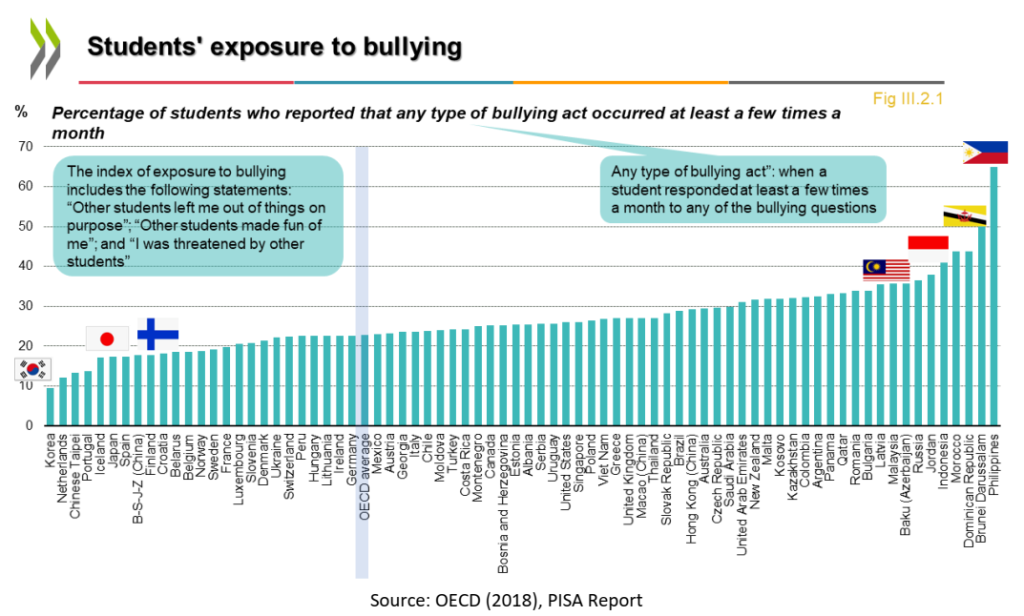Among the PISA-participating countries, the information reported by students reveals that the Philippines has the highest incidence of bullying, with 65% of students reporting that they were bullied at least a few times a month, compared to 23% on average across OECD countries. 29% of students reported skipping a day of school, and 61% of students had arrived late for school.
Bullying can be physical, verbal, psychological, or sexual, and it has devastating consequences for the affected children. In most countries, including the Philippines, frequently bullied students were likelier to have skipped school. Whereas students who valued school, enjoyed a better disciplinary climate, scored higher in the reading assessment, and received greater emotional support from parents were less likely to have skipped school.
This is consistent with a study that reported three in five respondents experienced bullying or peer violence during childhood. More females (70.5 percent) than males (59.8 percent) had experienced bullying. The most common triggers were physical appearance (including disabilities), status in life, and skin color.
Children’s most common bullying methods were verbal abuse, being laughed at; having faces made at them; menacing gestures, gossiping about, or ignoring. The most common perpetrators were other children at school and close friends. For many respondents, bullying was considered to be part of the fun among friends.
Table of Contents
Students’ Exposure to Bullying
Figure 1: Incidence of Bullying, PISA 2018
Eliminating bullying requires the total commitment of all key stakeholders, starting with schools, the communities, local authorities, and the Department of Education (DepEd).
In 2012, DepEd issued its Child Protection Policy which aims to provide a safer and more tolerant school environment.
A year later, Republic Act 10627 (Anti-Bullying Act of 2013) was enacted, requiring all elementary and secondary schools to adopt policies to address bullying in their respective institutions. Republic Act 10627 establishes detailed actions to be undertaken in schools to avoid bullying.
School-Related Gender-Based Violence
School-based violence refers to “physical, psychological and sexual violence that happened in the school setting where the perpetrators are the teachers or any adult in school.”
In the same report, 14.3 percent of the respondent who attended school declared having experienced physical violence in school. The prevalence of violence in children is similar regardless of socio-economic class. Some of this violence targets individuals or groups based on their gender.
According to UNICEF, “sexual harassment is the most frequent form of sexual violence in school settings, occurring in both primary and secondary schools, with girls being particularly vulnerable.” The LGBT community is particularly at risk of sexual violence at school, often from peers.
According to a baseline conducted by the Council for the Welfare of Children, 2 out of 3 children experienced physical violence, 1 out of 4 sexual violence, 2 out of 5 psychological violence, and 2 out of 3 violence from their peers.
According to the 2017 National Demographic and Health Survey, in the Philippines, 1 in 20 women and girls aged 15-49 have experienced sexual violence in their lifetime.
Regarding school-related gender-based violence (SRGBV) in public schools, the Department of Education (DepEd) organizes an annual campaign to end violence against women and children. The Gender-responsive basic education policy (DepEd Order No. 32, s. 2017) includes references to safe learning environments.
However, DepEd did not articulate specific mechanisms to implement that policy in the schools. DepEd Regional Office III has recently developed 14 Gender-Related School-Based Violence (GRBV) modules under the Gender Equality Movement in Schools of Central Luzon (GEMS-CL). The modules are oriented to raise awareness among teenagers on issues related to teenage pregnancy and school-related gender-based violence (SRGBV).
DepEd invited other sectors to provide inputs on developing the K-12 school curriculum to integrate child sexual exploitation within gender-based violence. A national committee and advocacy group were formed with family planning organizations in the Philippines and the Department of Health.

ask*
hello! may i kindly asked for the specific date as to when you published this article? i will be using this as reference on a research paper i am currently working on. hope you see this comment!